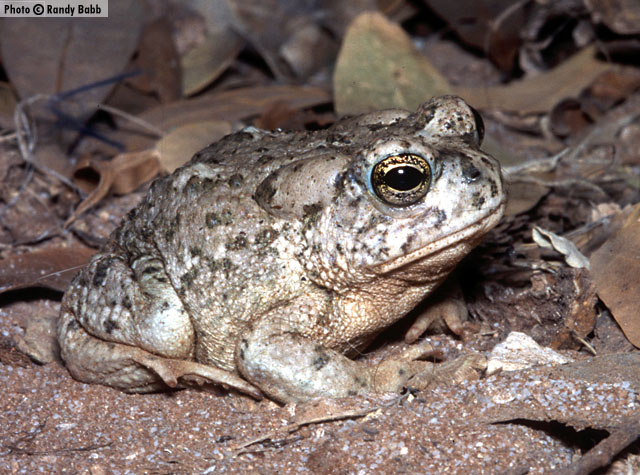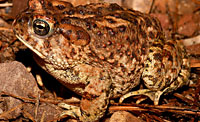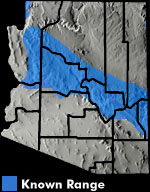Online Field Guide to The Reptiles and Amphibians of Arizona



Yavapai County, AZ
 Coconino Co., AZ |
| ARIZONA TOAD Anaxyrus microscaphus | |
|
DESCRIPTION: The Arizona toad is distinguishable from other anurans in Arizona by weak or absent cranial crests, oval parotoid glands (length = 1.7 x width), a weak or absent light dorsal stripe, a relatively smooth dorsum with few spots, warts low, relatively few tubercles, and typically there is a light band across and between the eyes. The anterior portions of the parotoid glands are also light colored. This is a medium-sized toad – adults range in size from 2.0-3.3 inches. The coloration of this species is quite variable depending on location, but is often gray above with beige, pale dull yellow, rust, brown, or pink hues. Juveniles tend to be light olive or salmon colored with reddish warts. Males have a round vocal sac when inflated; both sexes have a pale-colored throat. Tadpoles grow to about 1.5 inches. Small tadpoles are black, but as they grow the dorsal body color lightens and the tail becomes mottled or spotted. DISTRIBUTION: The Arizona toad is found from the Colorado and Virgin river basins in southern Nevada and southwestern Utah southeast through the lower mountains of Arizona mostly below the Mogollon Rim into the Mogollon Plateau of west-central New Mexico. In Arizona, at least 55 populations were documented from 1980-1995 in the Virgin, Bill Williams, Hassayampa, Agua Fria, Verde, Salt, San Francisco, Blue, and Little Colorado river drainages, as well as at Eagle Bonita creeks that drain to the Gila River. HABITAT: The species tends to be found in areas of shallow, flowing, permanent water over sandy or rocky substrates, typically in river canyons or foothill streams. Within these habitats, Arizona toads often select slower water or pools where the tree canopy is relatively open. Artificial habitats such as golf course ponds and irrigated croplands are also used, but such areas are frequently populated by Anaxyrus microscaphus X A. woodhousei hybrids or intergrades (see “Remarks”, below). BEHAVIOR: This species has a tendency to hop, instead of “walk.” Arizona toads do not stray very far from water or riparian habitats. REPRODUCTION AND CALLS: Breeding occurs over a relatively short period (10-12 days) in February-April. Breeding is not triggered by rainfall events. Arizona toads breed in pools, typically along streams and rivers. Eggs are laid in stringers on the bottom; clutches range from about 3150-4280. Eggs hatch in 3-6 days, and tadpoles typically metamorphose in 1-3 months, but development can be slower in cooler water or at higher elevations. The advertisement call is a trill that lasts 8-10 seconds. Calling males typically do not form large choruses but are often strung out singly along stream courses. DIET: Not well studied, but Arizona toads likely eat a variety of invertebrates. In southwestern Utah, Arizona toads fed upon sand crickets, beetles, true bugs, ants, bees, moth larvae, and snails. REMARKS: Hybridization occurs wherever Arizona toads occur with Woodhouse’s toads. Sullivan (1993) presented a hybrid-index score useful in determining degree of hybridization of intergradation. Dams and reservoirs, as well as golf course ponds, irrigation sumps and canals, and other human-altered aquatic systems have created still water favored by Woodhouse’s toads and facilitated niche overlap and hybridization between Arizona toads and Woodhouse’s toads. The Arizona toad has been replaced by Woodhouse’s toad at Alamo Lake, Lake Pleasant, the Verde Valley, and Fort Mohave (lower Colorado River). The Arizona toad was until recently considered conspecific with the Arroyo toad (Anaxyrus californicus) and Mexican toad (Anaxyrus mexicanus, see Gergus 1998). No subspecies are currently recognized. By Ernest Nigro and Jim Rorabaugh
Degenhardt, W.G., C.W. Painter, and A.H. Price. 1996. Amphibians and Reptiles of New Mexico. University of New Mexico Press, Albuquerque. Gergus, E.W.A. 1998. Systematics of the Bufo microscaphus Complex: allozyme evidence. Herpetologica 54(3):317-325. Price, A.H. and B.K. Sullivan. 1988. Bufo microscaphus. Catalogue of American Amphibians and Reptiles. (415):1-3. Schwaner, T.D., and B.K. Sullivan. 2005. Bufo microscaphus Cope 1867 “1866” Arizona toad. Pages 422-424 in M.J. Lannoo (ed), Amphibian Declines: The Conservation Status of United States Species. University of California Press, Berkeley, CA. Sullivan, B.K. 1993. Distribution and status of the Arizona toad, Bufo microscaphus microscaphus. Unpublished report to the Arizona Game and Fish Department, Phoenix, AZ. Sullivan, B.K. 2005. Southwestern desert bufonids. Pages 237-240 in M.J. Lannoo (ed), Amphibian Declines: The Conservation Status of United States Species. University of California Press, Berkeley, CA. |
|
Visit Partners in Amphibian and Reptile Conservation:


HOME
Copyright © 2023, Arizona Game and Fish Department. All rights reserved.
If you make use of the textual contents of this site in reports, publications, etc. please cite and credit the author(s) and photographer(s). All photos on this website are copyrighted. However, those found in the species account section may be used for any noncommercial scientific, educational, or conservation purposes provided that photographs are not altered and continue to bear the copyright symbol and name of the photographer. Please contact the photographer regarding commercial use of copyrighted photographs.










